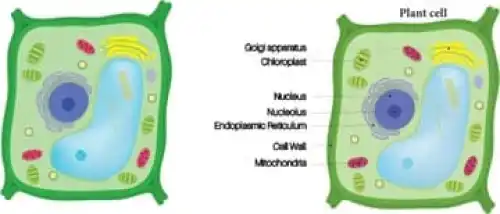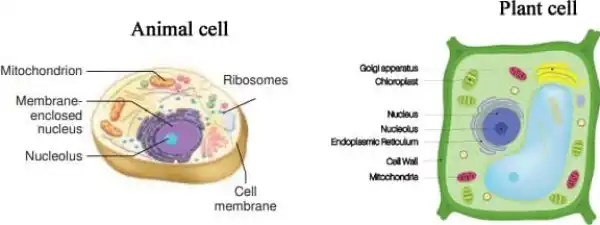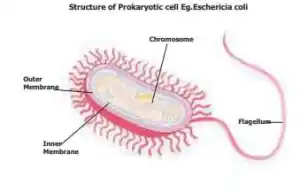6th Science Guide Term 2 Lesson 5 The Cell
6th Standard Science Term 2 Book Back Answers Lesson 5 The Cell – English Medium
6th Standard Science Term 2 Lesson 5 The Cell Book Back Question and answers English Medium download pdf. 6th All Subject Text Books download pdf. 6th Science Term 1 Guide. 6th All Subject Book Back Answers.

6th Science Guide Term 2 Lesson 5 The Cell
I. Choose the correct answer:
1. The unit of measurement used for expressing dimension (size) of cell is ____
- centimeter
- millimeter
- micrometer
- meter
Ans : micrometer
2. Under the microscope Priya observes a cell that has a cell wall and distinct nucleus. The cell that she observed is
- a plant cell
- an animal cell
- a nerve cell
- a bacteria cell
Ans : a plant cell
3. A ‘control centre’ of the eukaryotic cell is
- Cell wall
- Nucleus
- Vacuoles
- Chloroplast
Ans : Nucleus
4. Which one of the following is not an unicellular organism?
- Yeast
- Amoeba
- Spirogyra
- Bacteria
Ans : Spirogyra
5. Most organelles in a eukaryotic cell are found in the
- Cell wall
- cytoplasm
- nucleus
- Vacuole
Ans : cytoplasm
II. Fill in the blanks
- The instrument used to observe the cell is _____Ans : Microscope
- I control the food production of a cell. Who am I? ____Ans : chloroplast
- I am like a policeman. Who am I ____? Ans : cell wall
- The Term “ cell” was coined by ______Ans : Robert hooke
- The egg of an Ostrich is the ___________ single cell.Ans : largest
III. True or False. If False, give the correct statement
- A cell is the smallest unit of life.Ans : True
- Nerve cell is the longest cellAns : True
- Prokaryotes were the first form of life on earth.Ans : True
- The organelles of both plants and animals are made up of cellsAns : False
- An : The organelles of both plants and animals are made up of membranes.
- New cells are produced from existing cells.Ans : True
IV. Match the Following
- Control center – Cell membrane
- Food producer (Plant cell) – Mitochondria
- Gate of the nucleus – Nucleus
- Gate of the cell – Chloroplasts
- Energy producer – Nuclear membrane
Ans : 1 – C, 2 – D, 3 – E, 4 – A, 5 – B
V. Arrange in a correct sequence
1. Elephant, Cow, Bacteria, Mango, Rose plant
Ans : Bacteria, Rose plant, Mango tree ,Cow, Elephant.
2. Hen Egg, Ostrich egg, Insect egg
Ans : Insect egg, Hen Egg, Ostrich egg
VI. Analogy
1. Prokaryote : Bacteria :: Eukaryote :_______
Ans : Plant cell
2. Spirogyra : Plant cell :: Amoeba : ______
Ans : Animal cell
3. Food producer : Chloroplasts :: Power house :____
Ans : Mitochondria
VII. Give very short answer
1. Who discovered the cell in 1665?
- Robert hook
2. What type of cells do we have?
- Eukaryotic cell
3. What are the essential components of a cell?
- An outer cell membrane.
- A liquid cytoplasm.
- A nucleus.
4. What are the organelles found only in plant cell?
- Chloroplast, vacuoles
5. Give any three examples of eukaryotic cell?
- Plants, animals, most of the fungi and algae.
6. Which one is called as “Area of movement”?
- cytoplasam
7. Shiva said “ Bigger onion has larger cells when compared to the cells of smaller onion”! Do you agree with his statement or not ? Explain Why?
- I disagree. because the onion cells are same in size irrespective of size of onion.
VIII. Give short answer
1. Why cells are called building blocks of life?
- Like a brick wall, your body is composed of basic building blocks, and are named as “cells”.
2. Identify any four parts of the Plant cell.

3. Distinguish between prokaryotic and eukaryotic cells
|
Prokaryotic cell |
Eukaryotic cell |
|
1. It’s diameter ranges from 1 to 2 micron |
It’s diameter ranges from 10 to 100 micron |
|
2. Absence of membrane bound organelles |
Presence of membrane bound organelles |
|
3. Nucleus consisting of no nuclear membrane |
True nucleus consisting of nuclear membrane |
|
4. Absence of nucleoli |
Presence of nucleoli |
4. Make sketches of animal and plant cells which you observe under microscope.

5. Write about the contribution of Robert Hooke in cell biology.
- The Englishman Robert hooke was a scientist, mathematician, and inventor. He improved microscope which was used in those days, and built a compound microscope.
- He placed water-lens beside the microscope to focus the light from an oillamp on specimens to illuminate them brightly. So that he able to see the minute parts of the objects clearly
6th Science Guide Term 2 Lesson 5 The Cell
IX. Answer in detail
1. Tabulate any five cell organelles and their function.
|
Cell Components |
Main Functions |
Special Name |
|
1. Cell wall |
• Surrounds and protects the cell |
Supporter and protector |
|
2. Cell membrane |
• Holds and protects the cell |
Gate of the cell |
|
3. Cytoplasm |
• A watery, gel-like material in which cell parts move |
Area of movement |
|
4. Mitochondria |
• Produce and supply most of the energy for the cell |
Power house of the cell |
|
5. Chloroplasts |
• Contain green pigment chlorophyll |
Food producers for the cell (Plant cell) |
|
6. Vacuoles |
• Store food, water, and chemicals |
Storage tanks |
|
7. Nucleus |
• Acts as ‘brain’ of the cell |
Control centre |
|
8 Nucleus membrane |
• Surrounds and protects the nucleus control the movement of materials in and out of the nucleus |
Gate of the nucleus |
2. Draw a neat labelled diagram of a prokaryotic cell.
- The unicelluar organisms like Bacteria has Prokaryotic cells. It has No true nucleus. This type of nucleus is called as nucleiod. No nuclear membrane is around this nucleiod. These cells were the first form of life on earth. It is ranging from 0.003 to 2.0 micro meter in diameter.





